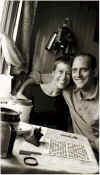To Asia by Rail
Sunday 30 May 1999 – Tuesday 1 June 1999
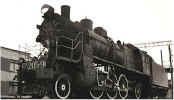 The Trans-Siberian railway
across Russia to the Pacific Ocean port of Vladivostok was completed in 1901.
Prior to that, travel across Siberia was nonetheless popular among
Victorian explorers, many of whom made the journey using alternative forms of
transport including carriage, sledge, bicycle and even their feet.
In those days, Siberia was considered to be an inhospitable land where
murderers and other convicts were sent into exile to work in the infamous salt
mines. Even today, there is something romantic about travelling across this land by train, watching the
expansive scenery flashing past your window and reading about its history as you go.
The Trans-Siberian railway
across Russia to the Pacific Ocean port of Vladivostok was completed in 1901.
Prior to that, travel across Siberia was nonetheless popular among
Victorian explorers, many of whom made the journey using alternative forms of
transport including carriage, sledge, bicycle and even their feet.
In those days, Siberia was considered to be an inhospitable land where
murderers and other convicts were sent into exile to work in the infamous salt
mines. Even today, there is something romantic about travelling across this land by train, watching the
expansive scenery flashing past your window and reading about its history as you go.
Some of the old steam trains are
still displayed at stations along the Trans-Siberian route as a 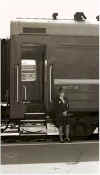 nostalgic
reminder of days gone by, but today the working trains are electric and most of the
carriages made in
(formerly East) Germany. Each
carriage is staffed by two formidable looking attendants called provodnitsas who take it in turns to work shifts over each 24 hour period.
Their main duties (other than ensuring you have a valid ticket to travel)
include providing a constant stream of hot water for tea and coffee and ushering
you back onto the train at each of the numerous stops.
nostalgic
reminder of days gone by, but today the working trains are electric and most of the
carriages made in
(formerly East) Germany. Each
carriage is staffed by two formidable looking attendants called provodnitsas who take it in turns to work shifts over each 24 hour period.
Their main duties (other than ensuring you have a valid ticket to travel)
include providing a constant stream of hot water for tea and coffee and ushering
you back onto the train at each of the numerous stops.
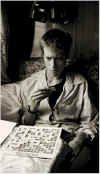 We had been warned in the
guidebooks not to bring epics such as War and Peace with us to read on the
journey as they would never get finished and it was indeed remarkable how
quickly time flew – perhaps in part because of the five separate time zones we
crossed over the course of our three-day journey. The days were mainly spent watching the views from our window, playing
Scrabble, reading, stretching our legs when we could
at certain station stops and eating. The
accommodation was far from luxurious but first class travel did entail a
portable TV perched precariously above the door and which, judging from the
shouting and gunshots emanating from our neighbours’ compartments, actually
worked (then again, maybe it wasn't the TV).
We had been warned in the
guidebooks not to bring epics such as War and Peace with us to read on the
journey as they would never get finished and it was indeed remarkable how
quickly time flew – perhaps in part because of the five separate time zones we
crossed over the course of our three-day journey. The days were mainly spent watching the views from our window, playing
Scrabble, reading, stretching our legs when we could
at certain station stops and eating. The
accommodation was far from luxurious but first class travel did entail a
portable TV perched precariously above the door and which, judging from the
shouting and gunshots emanating from our neighbours’ compartments, actually
worked (then again, maybe it wasn't the TV).
There was also a so-called “bathroom” (consisting of a toilet and
wash basin)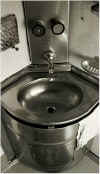 at the end of each carriage, and although traveling first class meant
you shared it with a mere 20 others, washing was a challenge.
Birdbaths became all the rage over the course of our three days, using
one hand to push the lever behind the tap up with brute force in order to
release the water while holding a flannel under the flow of cold water with the
other. The toilet was an
interesting contraption too; we soon figured out why the bathroom always seemed
to be locked as we approached a station when we realised that you could see the
ground rushing by below as you put your foot down on the pedal to flush.
at the end of each carriage, and although traveling first class meant
you shared it with a mere 20 others, washing was a challenge.
Birdbaths became all the rage over the course of our three days, using
one hand to push the lever behind the tap up with brute force in order to
release the water while holding a flannel under the flow of cold water with the
other. The toilet was an
interesting contraption too; we soon figured out why the bathroom always seemed
to be locked as we approached a station when we realised that you could see the
ground rushing by below as you put your foot down on the pedal to flush.
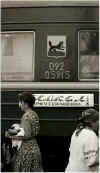 On the first day, we covered
about 1700km (1000 miles). There
were kilometre
posts located the entire way along the southern side of the track showing the
number of kilometres to Moscow or Vladivostok depending on the direction of
travel. They were
almost impossible to see but when we managed to catch a number as it flashed by,
we were able to orientate ourselves between stations. Each stop varied
in length but at the main stations, we would have about 10-12 minutes to stretch
our legs along the platform before being ushered back on board by the provodnitsa. At
each stop, a multitude of local men and women would appear selling food and
drink and running along the length of the
On the first day, we covered
about 1700km (1000 miles). There
were kilometre
posts located the entire way along the southern side of the track showing the
number of kilometres to Moscow or Vladivostok depending on the direction of
travel. They were
almost impossible to see but when we managed to catch a number as it flashed by,
we were able to orientate ourselves between stations. Each stop varied
in length but at the main stations, we would have about 10-12 minutes to stretch
our legs along the platform before being ushered back on board by the provodnitsa. At
each stop, a multitude of local men and women would appear selling food and
drink and running along the length of the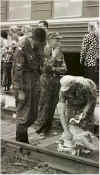 platform knocking on carriage windows
or displaying their wares on small, portable stalls. Given that there was nowhere to buy food on the train, there
was never any shortage of people keen to buy and it became a photo opportunity
at each stop as we watched travellers haggling over prices and vendors becoming
ever more inventive in ways to attract the attention of passengers.
platform knocking on carriage windows
or displaying their wares on small, portable stalls. Given that there was nowhere to buy food on the train, there
was never any shortage of people keen to buy and it became a photo opportunity
at each stop as we watched travellers haggling over prices and vendors becoming
ever more inventive in ways to attract the attention of passengers.
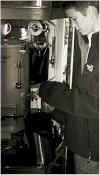 For the majority of the first
day, the scenery was predominantly a forest of birch and fir trees not
unlike those in England. Shortly
after leaving Perm, however, the landscape changed
abruptly and gave way to meadows and fields, also remarkably similar to those
back home. That evening, we crossed
the Urals; it
was certainly not the impressive mountain range we had been expecting, and by
morning we were distinctly disappointed to observe that the scenery still
looked the same as it had done the day before in Europe.
That said, the sudden appearance of oriental features and the onset of
"train-lag" underscored that we were now in Asia.
For the majority of the first
day, the scenery was predominantly a forest of birch and fir trees not
unlike those in England. Shortly
after leaving Perm, however, the landscape changed
abruptly and gave way to meadows and fields, also remarkably similar to those
back home. That evening, we crossed
the Urals; it
was certainly not the impressive mountain range we had been expecting, and by
morning we were distinctly disappointed to observe that the scenery still
looked the same as it had done the day before in Europe.
That said, the sudden appearance of oriental features and the onset of
"train-lag" underscored that we were now in Asia.
On our second day, we travelled
close to another 2000km (1200 miles). One of our
main stops that day was at a town called Omsk, which is the second largest city
in Siberia and noticeably more high-tech that some of the stations we had passed
through the day before (each platform had a notice board with the train number
and destination on it). Much of the produce being sold here was dairy – milk, cheese, yoghurt
–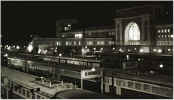 which was in stark contrast to the seemingly popular delicacy of dried fish
further down the line at Barabinsk. That
evening, Eric stayed up to get off the train as we pulled into Novosibirsk in
the early hours, simply to take some photos of Siberia’s
largest station. It takes all
sorts!
which was in stark contrast to the seemingly popular delicacy of dried fish
further down the line at Barabinsk. That
evening, Eric stayed up to get off the train as we pulled into Novosibirsk in
the early hours, simply to take some photos of Siberia’s
largest station. It takes all
sorts!
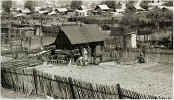 By lunchtime the following day,
we had reached Krasnoyarsk on the banks of the Yenisei River and further down
the line, crossed the halfway point between Moscow and Beijing.
From here, the countryside became noticeably flatter and by evening it
was only another eight hours to Irkutsk.
By lunchtime the following day,
we had reached Krasnoyarsk on the banks of the Yenisei River and further down
the line, crossed the halfway point between Moscow and Beijing.
From here, the countryside became noticeably flatter and by evening it
was only another eight hours to Irkutsk.
We were awakened early by the
provodnitsa and scrambled to pack our bags before pulling into the station.
Three days of travel had sped by and there was only one thing we had
missed: a hot shower.
